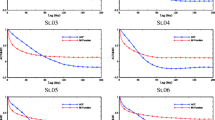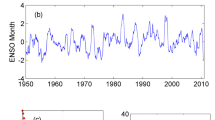Abstract
Lake water level forecasting is very important for an accurate and reliable management of local and regional water resources. In the present study two nonlinear approaches, namely phase-space reconstruction and self-exciting threshold autoregressive model (SETAR) were compared for lake water level forecasting. The modeling approaches were applied to high-quality lake water level time series of the three largest lakes in Sweden; Vänern, Vättern, and Mälaren. Phase-space reconstruction was applied by the k-nearest neighbor (k-NN) model. The k-NN model parameters were determined using autocorrelation, mutual information functions, and correlation integral. Jointly, these methods indicated chaotic behavior for all lake water levels. The correlation dimension found for the three lakes was 3.37, 3.97, and 4.44 for Vänern, Vättern, and Mälaren, respectively. As a comparison, the best SETAR models were selected using the Akaike Information Criterion. The best SETAR models in this respect were (10,4), (5,8), and (7,9) for Vänern, Vättern, and Mälaren, respectively. Both model approaches were evaluated with various performance criteria. Results showed that both modeling approaches are efficient in predicting lake water levels but the phase-space reconstruction (k-NN) is superior to the SETAR model.








Similar content being viewed by others
References
Abarbanel HDI, Brown R, Kadtke JB (1990) Prediction in chaotic nonlinear systems: methods for time series with broadband Fourier spectra. Phys Rev A 41:1782–1807
Abarbanel HDI, Brown R, Sidorowich JJ, Tsimring LS (1993) The analysis of observed chaotic data in physical systems. Rev Mod Phys 65(4):1331–1392
Altunkaynak A (2007) Forecasting surface water level fluctuations of Lake Van by artificial neural networks. Water Resour Manage 21:399–408
Amendola A, Storti G (2001) Nonlinear model for forecasting hydrological time series. In: Piccolo D, Ubertini L (eds) Metodi Statistici e Matematici per l’Analisi delle Serie Idrologicle. pp 1–9
Amendola A, Niglio M, Vitale C (2006a) The moments of SETARMA models. J Stat Probab Lett 76:625–633
Amendola A, Niglio M, Vitale C (2006b) Multi-step SETARMA predictors in the analysis of hydrological time series. Phys Chem Earth Parts A/B/C 31(18):1118–1126
Asefa T, Kemblowski M, Lall U, Urroz G (2005) Support vector machines for nonlinear state space reconstruction: application to the great salt lake time series. Water Resour Res 41(12):10
Baratta D, Cicioni G, Masulli F, Studer L (2003) Application of an ensemble technique based on singular spectrum analysis to daily rainfall forecasting. Neural Netw 16:375–387
Boero G, Marrocu E (2002) The performance of non-linear exchange rate models: a forecasting comparison. J Forecast 21:513–542
Chen C-S, Liu C-H, Su H-C (2008) A nonlinear time series analysis using two-stage genetic algorithms for streamflow forecasting. Hydrol Process 22(18):3697–3711. doi:10.1002/hyp.6973
Dahl M, Pers BC (2004) Comparison of four models simulating phosphorus dynamics in Lake Vänern, Sweden. Hydrol Earth Syst Sci 8(6):1153–1163
de Vos NJ, Rientjes THM (2005) Constraints of artificial neural networks for rainfall-runoff modeling: trade-offs in hydrological state representation and model evaluation. Hydrol Earth Syst Sci 9:111–126
Dunning C (2009) Hydrological modeling of the upper South Saskatchewan River Basin: multi-basin calibration and gauge de-clustering analysis. University of Waterloo, Waterloo
Farmer DJ, Sidorowich JJ (1987) Predicting chaotic time series. Phys Rev Lett 59:845–848
Frazer AM, Swinney HL (1986) Independent coordinates for strange attractors from mutual information. Phys Rev A 33(2):1134–1140
Frison T, Abarbanel H, Earle M, Schultz J, Sheerer W (1999) Chaos and predictability in ocean water level measurements. J Geophys Res Oceans 104:7935–7951
Güldal V, Tongal H (2010) Comparison of recurrent neural network, adaptive neuro-fuzzy inference system and stochastic models in Eğirdir Lake level forecasting. Water Resour Manage 24:105–128
Hu TS, Lam KC, Ng ST (2001) River flow time series prediction with a range-dependent neural network. Hydrol Sci 46(5):729–745
Hu TS, Wu FY, Zhang X (2007) Rainfall-runoff modeling using principal component analysis and neural network. Nord Hydrol 38(3):235–248
Islam MN, Sivakumar B (2002) Characterization and prediction of runoff dynamics: a nonlinear dynamical view. Adv Water Resour 25(2):179–190
Jain KS, Sudheer KP (2008) Fitting of hydrologic models: a close look at the Nash-Sutcliffe Index. J Hydrol Eng 10:918–986
Jayawardena AW, Gurung AB (2000) Noise reduction and prediction of hydrometeorological time series: dynamical systems approach vs. stochastic approach. J Hydrol 228:242–264
Josefsson M, Andersson B (2001) The environmental consequences of alien species in the Swedish lakes Mälaren, Hjälmaren, Vänern and Vättern. Ambio 30(8):514–521
Khatibi R, Ghorbani M, Aalami M, Kocak K, Makarynskyy O, Makarynska D, Aalinezhad M (2011) Dynamics of hourly sea level at Hillarys Boat Harbour, Western Australia: a chaos theory perspective. Ocean Dyn 61(11):1797–1807. doi:10.1007/s10236-011-0466-8
Khatibi R, Sivakumar B, Ghorbani MA, Kisi O, Koçak K, Farsadi Zadeh D (2012) Investigating chaos in river stage and discharge time series. J Hydrol 414–415:108–117. doi:10.1016/j.jhydrol.2011.10.026
Khokhlov V, Glushkov A, Loboda N, Serbov N, Zhurbenko K (2008) Signatures of low-dimensional chaos in hourly water level measurements at coastal site of Mariupol, Ukraine. Stoch Env Res Risk Assess 22:777–787
Kitanidis PK, Bras RL (1980) Real-time forecasting with a conceptual hydrologic model 2. Applications and results. Water Resour Res 16:1034–1044
Komorník J, Komornikova M, Mesiar R, Szökeova D, Szolgay J (2006) Comparison of forecasting performance of nonlinear models of hydrological time series. Phys Chem Earth 31:1127–1145
Kozhevnikova IA, Shveikina VI (2008) Nonlinear dynamics of level variations in the Caspian Sea. Water Resour 35(3):297–304. doi:10.1134/s0097807808030056
Kvarnäs H (2001) Morphometry and hydrology of the four large lakes of Sweden. Ambio 30(8):467–474
Laio F, Porporato A, Revelli R, Ridolfi L (2003) A comparison of nonlinear flood forecasting methods. Water Resour Res 39(5):1129. doi:10.1029/2002WR001551
Lall UT, Abarbanel H (1996) Nonlinear dynamics of the great salt lake: nonparametric short-term forecasting. Water Resour Res 32(4):975–985
Lall U, Sharma A (1996) A nearest neighbor bootstrap for resampling hydrologic time series. Water Resour Res 32(3):679–693
Lee T, Ouarda TBMJ (2011) Identification of model order and number of neighbors for k-nearest neighbor resampling. J Hydrol 404(3–4):136–145. doi:10.1016/j.jhydrol.2011.04.024
Li Q, Sun R, Tricaud C, Chen Y (2007) Great Salt Lake surface level forecasting using FIGARCH modeling. International design engineering technical conferences and computers and information in engineering conference. University of Nevada, Las Vegas, pp 1–10
Lisi F, Villi V (2001) Chaotic forecasting of discharge time series: a case study. J Am Water Resour Assoc 37(2):271–279
Lisi F, Nicolis O, Sandri M (1995) Combining singular-spectrum analysis and neural networks for time series forecasting. Neural Process Lett 2(4):6–10
Liu Q, Islam S, Rodriguez-Iturbe I, Le Y (1998) Phase-space analysis of daily streamflow: characterization and prediction. Adv Water Resour 21(6):463–475
Marques CAF, Ferreira J, Rocha A, Castanheira J, Gonçalves P, Vaz N, Dias JM (2006) Singular spectral analysis and forecasting of hydrological time series. Phys Chem Earth 31:1172–1179
Nash JE, Sutcliffe JV (1970) River flow forecasting through conceptual models, Part I—a discussion of principles. J Hydrol 10:282–290
Ng WW, Panu US, Lennox WC (2007) Chaos based analytical techniques for daily extreme hydrological observations. J Hydrol 342:17–41
Packard NH, Crutchfield JP, Farmer JD, Shaw RS (1980) Geometry from a time series. Phys Rev Lett 45(9):712–716
Phoon K, Islam M, Liaw C, Liong S (2002) Practical inverse approach for forecasting nonlinear hydrological Time series. J Hydrol Eng 7(2):116–128
Porporato A, Ridolfi L (1997) Nonlinear analysis of river flow time sequences. Water Resour Res 33(6):1353–1367
Randrianasolo A, Ramos MH, Andréassian V (2011) Hydrological ensemble forecasting at ungauged basins: using neighbour catchments for model setup and updating. Adv Geosci 29:1–11. doi:10.5194/adgeo-29-1-2011
Regonda SK, Sivakumar B, Jain A (2004) Temporal scaling in river flow: can it be chaotic? Hydrol Sci J 49(3):373–385
Reinart A, Reinhold M (2008) Mapping surface temperature in large lakes with MODIS data. Remote Sens Environ 112:603–611
Schuster HG (1988) Deterministic Chaos. VCH, Weinheim
Sharma A, Tarboton DG, Lall U (1997) Streamflow simulation: a nonparametric approach. Water Resour Res 33(2):291–308
Sivakumar B (2003) Forecasting monthly streamflow dynamics in the western United States: a nonlinear dynamical approach. Environ Model Softw 18(8–9):721–728
Sivakumar B (2004) Dominant processes concept in hydrology: moving forward. Hydrol Process 18(12):2349–2353
Sivakumar B, Jayawardena AW (2002) An investigation of the presence of low-dimensional chaotic behaviour in the sediment transport phenomenon. Hydrol Sci J 47(3):405–416
Sivakumar B, Jayawardena AW, Fernando TMKG (2002) River flow forecasting: use of phase-space reconstruction and artificial neural networks approaches. J Hydrol 265(1–4):225–245
Sivapragasam C, Liong SY, Pasha MFK (2001) Rainfall and runoff forecasting with SSA–SVM approach. J Hydroinformatics 3(7):141–152
St-Hilaire A, Ouarda TBMJ, Bargaoui Z, Daigle A, Bilodeau L (2012) Daily river water temperature forecast model with a k-nearest neighbour approach. Hydrol Process 26:1302–1310
Strömbeck N, Pierson DC (2001) The effects of variability in the inherent optical properties on estimations of chlorophyll a by remote sensing in Swedish freshwaters. Sci Total Environ 268:123–137
Sugihara G, May RM (1990) Nonlinear forecasting as a way of distinguishing chaos from measurement error in time series. Nature 344:734–741
Takens F (1981) Detecting strange attractors in turbulence. In: Rand DA, Jung LS (eds) Dynamical systems and turbulence, lecture notes in mathematics, vol 898. Springer-Verlag, Berlin, p 366
Tong H (1978) On threshold model. Pattern recognition and signal processing. Sijhoff and Noordhoff, Amsterdam
Tong H (1983) Threshold models in nonlinear time series analysis. Springer-Verlag, New York
Tong H (1990) Non-linear time series: a dynamical system approach. Clarendon Press, Oxford
Tongal H, Demirel MC, Booij MJ (2013) Seasonality of low flows and dominant processes in the Rhine River. Stoch Env Res Risk Assess 27(2):489–503. doi:10.1007/s00477-012-0594-9
Toth E, Brath A, Montanari A (2000) Comparison of short-term rainfall prediction models for real-time flood forecasting. J Hydrol 239(1–4):132–147. doi:10.1016/S0022-1694(00)00344-9
Tsay RS (1989) Testing and modelling multivariate threshold models. J Am Stat Assoc 93:1188–1202
Tsonis AA, Elsner JB (1988) The weather attractor over very short timescales. Nature 333:545–547
Wang W (2006) Stochasticity, nonlinearity and forecasting of streamflow processes. Nanjing University, Nanjing
Weyhenmeyer GA, Westöö AK, Willén E (2008) Increasingly ice-free winters and their effects on water quality in Sweden’s largest lakes. Hydrobiologia. doi:10.1007/s10750-007-9188-9
Willén E (2001) Four decades of research on the Swedish Large Lakes Mälaren, Hjälmaren, Vättern and Vänern: the significance of monitoring and remedial measures for a sustainable society. J Hum Environ 30(8):458–466
Wu CL, Chau KW (2010) Data-driven models for monthly streamflow time series prediction. Eng Appl Artif Intell 23:1350–1367
Wu CL, Chau KW, Li YS (2009) Predicting monthly streamflow using data-driven models coupled with data-preprocessing techniques. Water Resour Res 45(8):W08432. doi:10.1029/2007wr006737
Wu CL, Chau KW, Fan C (2010) Prediction of rainfall time series using modular artificial neural networks coupled with data-preprocessing techniques. J Hydrol 389(1–2):146–167. doi:10.1016/j.jhydrol.2010.05.040
Yarar A, Onüçyıldız M, Copty NK (2009) Modelling level change in lakes using neuro-fuzzy and artificial neural networks. J Hydrol 365:329–334
Zaldivar JM, Gitiêrrez E, Galvân IM, Strozzi F, Tomasin A (2000) Forecasting high waters at Venice Lagoon using chaotic time series analysis and nonlinear neural networks. J Hydroinformatics 2:61–84
Acknowledgments
R. Berndtsson acknowledges helpful funding from the MECW project at the Center for Middle Eastern Studies, Lund University.
Author information
Authors and Affiliations
Corresponding author
Rights and permissions
About this article
Cite this article
Tongal, H., Berndtsson, R. Phase-space reconstruction and self-exciting threshold modeling approach to forecast lake water levels. Stoch Environ Res Risk Assess 28, 955–971 (2014). https://doi.org/10.1007/s00477-013-0795-x
Published:
Issue Date:
DOI: https://doi.org/10.1007/s00477-013-0795-x




